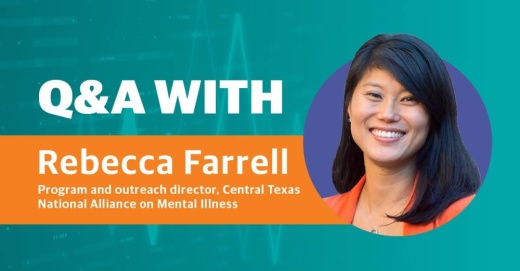Farrell said the pandemic laid bare existing deficiencies in mental health care, especially for children and minority communities. But she noted that as mental health came to the forefront in the pandemic, conversations about mental health became more “mainstream”—which she hopes will lead to greater education on mental illnesses.
Answers have been edited for length and clarity.
What does the state of mental health care look like, two years into the pandemic?
So the pandemic really has brought to light two primary issues. The first one is how extensive the gaps in our health care systems are, and then the second—which people might not have been aware of—is how we lack the support and resources for addressing our youth and adolescents mental mental health.
So the pandemic has brought to light those two primary issues, and with that, what we have noticed is that there's been an increase in the number of ER visits, especially amongst our youth and adolescents. ... Since 2017, suicide has become the eighth leading cause of death for our children, ages 5-11, and it is the second leading cause of death for our youth ages 10-24 since 2018.
... So when we look at our health care providers, ... what we have witnessed during the pandemic is higher, higher levels of empathy fatigue, ... And so we have noticed that people are mass exiting their places of employment, because they're experiencing so much emotional distress, anxiety and depression.
... We see long wait lists, because things have moved to telehealth. ... What we also noticed when the pandemic hit was that there was a dramatic change in mental health assistance, and then also we saw an increase in mental health, emergency consultations and in home care as well.
What populations are hit the hardest by the pandemic as it relates to mental health?
We know that suicide rates are higher amongst males. And, and then also, overall, the suicide rates are higher amongst white males who are older as well. ... Males will have died by suicide at a higher rate than females, however, females are more likely to ... attempt suicide. And we are seeing a rise in suicide attempts by African American females and also from our children who identify as LGBTQ+.
What are some barriers to accessing care?
So when we look at access to care, we want to look at what's available ... instead of quality. The second aspect we consider is of those providers, how many actually look like individuals who are seeking [care] back home? So we know that [Black, indigenous and people of color] members are less likely to seek help, even if it exists, because they may not have a provider who looks like them.
... The other reasons that we have a lack of access to health care is insurance. ... If you are underinsured, then you're really limited in the scope of where you can go and receive [care], or even if you don't have insurance [you’re] really limited. And how many geographical locations or communities offer free health care, or have free health care clinics? And then, if you have Medicaid, you know, certain health care systems have a cap on how many Medicaid patients they will accept, you know, and so even having insurance may hinder your ability to receive care, because the providers may not accept those insurances.
How has the perception of mental health changed?
If we do try to look at silver linings, our experiences of the pandemic has opened the door more in terms of being able to talk about mental health, about normalizing conversations about mental health.
However, I want to say—in my opinion—the conversations about mental health being normalized seem to focus more on anxiety and depression, not so much the other mental health conditions that people may experience, which we consider more severe in nature. So, you know, those individuals who may have schizophrenia diagnosis or who might have borderline personality diagnoses, bipolar diagnosis.
So, to me, people are OK with being able to say, 'Hey, I have anxiety, or I have depression, or I'm experiencing these symptoms of anxiety, depression.' Whereas I don't see people as much saying, 'Hey, I've been diagnosed with bipolar disorder or borderline personality disorder or schizophrenia or even autism.'
I think we're starting conversation. We're starting with anxiety, depression. I hope that we'll be able to move on to other mental health conditions that exist.
And then also, we're beginning to talk about how mental health is really connected to our physical health. So being able to say mental health is health. ... We are seeing more people wanting to learn about mental health conditions. ... They want to have a better understanding of what they are experiencing internally, if they're having mental health conditions. ... If a loved one or friend or coworker is experiencing mental health conditions and is acting differently, they want to have a better understanding and knowledge base of what is going on.
How would you say the ‘never-ending news feed’ affects mental health?
It is so important to have boundaries about what we expose ourselves to. ... Having this constant feed of news can contribute to the feelings of being overwhelmed, depressed, anxious, which can really be magnified if we don't engage in our boundaries and self care.
On the flip side, though, people may become desensitized to what is going on. ... Everybody experiences things very differently, and we just don't want to make assumptions. What we want to do is really understand it from their perspective. And so sometimes people who may say they are desensitized or that 'Oh, I'm not interested. I don't care about that,’ it may be their way of coping with the inundation of negative news.
And so I think it's important to keep abreast and informed about what is going on in our politics in our world, but finding a balance also between both positive and negative news, you know, so if you're watching a lot of negative news to be able to end it with something that's positive and uplifting.
Speaking of self-care, what are some other things we can do in our day-to-day lives?
It's important for us to understand how stress affects us, share similar diagnostic criteria, characteristics of very individual lives. So depression may not look the same between two people, because it's personal. ... So being able to understand how stress affects you—what happens to your mind, your thoughts, ... inside your body, internally, your feelings and so forth—it's really important.
And then I like to share with people to remember our ABCs, ... so being able to identify different types of strategies based on the letters of the alphabet. So for example, you know, I have, [A for] acknowledge. Acknowledge what you're experiencing; acknowledge what other people are experiencing and affirm. Try not to be too dismissive or ignorant of what is going on.
... [B is for] breathing and so forth. Breathing is very natural to us. But I think our true breathing—we may not engage in all the time— but really to take the time to really focus on that breathing. ... And then [C is for] coping skills. We all have coping skills; they may vary from person to person, but to use our coping skills and our positive coping skills.
Keep on your routine. So that's the next one. Establish those routines; maintain those routines. And then focus on what you can control, and spend time with your friends and family. Route yourself. Give yourself grace. And then I like to say, humor—let's laugh. I think sometimes we forget to find humor, to laugh. Maybe we think things are too serious; we shouldn't be able to laugh and joke about it. But, you know, humor is really good; laughing is really good.
... The other thing that they can do is contact ... the closest [NAMI] affiliate. ... We are a vital resource, and we provide resources and programs, education support and advocacy for free to those who participate who partake in them. ... And, finally, it's OK to ask for help—to accept that it is OK to ask for help. And then it is OK to not be OK.





